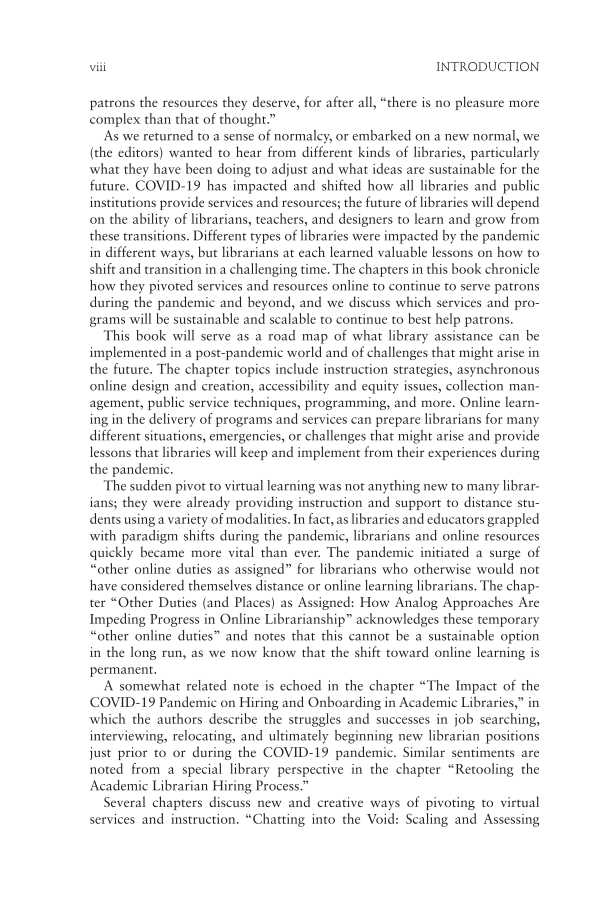viii Introduction patrons the resources they deserve, for after all, “there is no pleasure more complex than that of thought.” As we returned to a sense of normalcy, or embarked on a new normal, we (the editors) wanted to hear from different kinds of libraries, particularly what they have been doing to adjust and what ideas are sustainable for the future. COVID-19 has impacted and shifted how all libraries and public institutions provide services and resources the future of libraries will depend on the ability of librarians, teachers, and designers to learn and grow from these transitions. Different types of libraries were impacted by the pandemic in different ways, but librarians at each learned valuable lessons on how to shift and transition in a challenging time. The chapters in this book chronicle how they pivoted services and resources online to continue to serve patrons during the pandemic and beyond, and we discuss which services and pro- grams will be sustainable and scalable to continue to best help patrons. This book will serve as a road map of what library assistance can be implemented in a post-pandemic world and of challenges that might arise in the future. The chapter topics include instruction strategies, asynchronous online design and creation, accessibility and equity issues, collection man- agement, public service techniques, programming, and more. Online learn- ing in the delivery of programs and services can prepare librarians for many different situations, emergencies, or challenges that might arise and provide lessons that libraries will keep and implement from their experiences during the pandemic. The sudden pivot to virtual learning was not anything new to many librar- ians they were already providing instruction and support to distance stu- dents using a variety of modalities. In fact, as libraries and educators grappled with paradigm shifts during the pandemic, librarians and online resources quickly became more vital than ever. The pandemic initiated a surge of “other online duties as assigned” for librarians who otherwise would not have considered themselves distance or online learning librarians. The chap- ter “Other Duties (and Places) as Assigned: How Analog Approaches Are Impeding Progress in Online Librarianship” acknowledges these temporary “other online duties” and notes that this cannot be a sustainable option in the long run, as we now know that the shift toward online learning is permanent. A somewhat related note is echoed in the chapter “The Impact of the COVID-19 Pandemic on Hiring and Onboarding in Academic Libraries,” in which the authors describe the struggles and successes in job searching, interviewing, relocating, and ultimately beginning new librarian positions just prior to or during the COVID-19 pandemic. Similar sentiments are noted from a special library perspective in the chapter “Retooling the Academic Librarian Hiring Process.” Several chapters discuss new and creative ways of pivoting to virtual services and instruction. “Chatting into the Void: Scaling and Assessing
Document Details My Account Print multiple pages
Print
You have printed 0 times in the last 24 hours.
Your print count will reset on at .
You may print 0 more time(s) before then.
You may print a maximum of 0 pages at a time.













































































































































































































































































